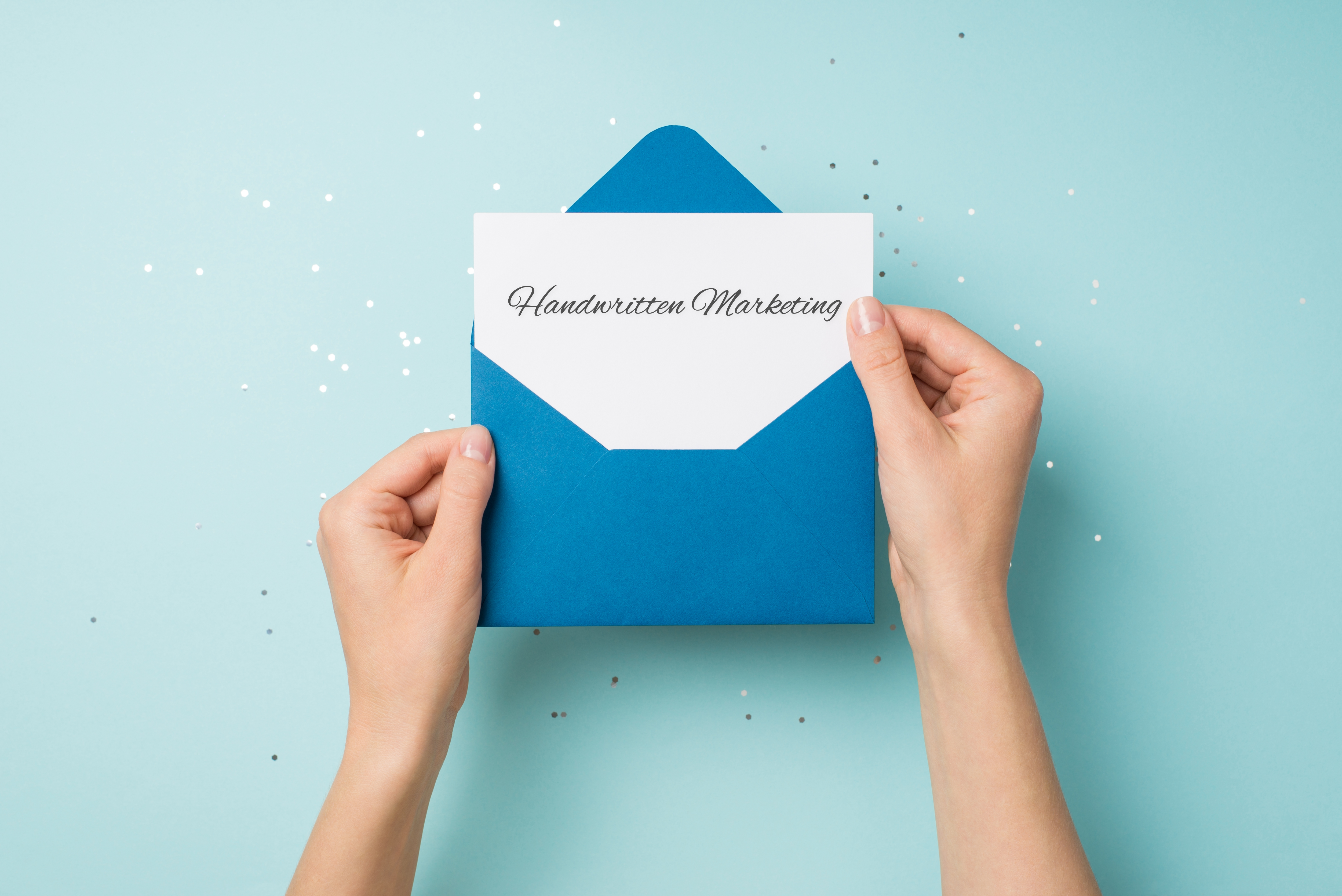
I hope you enjoy reading this blog post. If you want our handwritten notes to drive more sales for you, click here.
3 Wow Moments in Handwritten Marketing: Nudges, Notes, and Next-Level Tech

In a time when everything is connected to the internet, handwritten marketing is nothing more than a waste of time, right? Decades have passed since the age of handwritten marketing. We have more digital tools available today than ever before. But…
The digital landscape has grown exponentially in an unreal time frame and people are overstimulated. The hum of the internet is growing annoying and marketers need something fresh and client-focused. Open the vaults and take out handwritten marketing. Marketing has come full circle and handwriting is effective again!
So if you’re looking for a way to stand out from the competition and connect with your customers on a deeper level, handwritten direct mail marketing is just what you need.
Handwritten Marketing in History
Writing didn’t start out as the alphabet we use today. The first writing was created on cave walls 40,000 years ago in Lascaux and Altamira, according to The SAGE Handbook of Writing Development. Symbolic writing has also been found from the Chinese 10,000 years ago, Hittites 8,000 years ago and North American aboriginal people 4,000 years ago, the handbook reveals.
Ancient civilizations used symbolic writing as a means of advertisement. They hung posters and painted walls. “Wall and rock painting is an ancient advertising manifestation which is still popular in many parts of the world. Notably, researchers have started investigating the history of advertising from the commercial communication and sales messages on the walls in the ancient Roman Empire,” according to Academic Research International.
How does handwritten marketing work? Let’s begin by learning more about the consumer and why they react the way they do to marketing.
The Psychology of Consumer Behavior
There are a number of psychological theories studying consumer behavior. One key theory is called “motivation theory” which suggests that people are motivated to purchase goods and services in order to satisfy certain needs. Another important theory is “cognitive dissonance theory” which posits that people often purchase goods that they believe will reduce or eliminate any negative feelings they have (such as guilt, anxiety, insecurity, etc.).
Additionally, there are a number of other factors that can influence consumer behavior including social influences (such as peer pressure), individual differences (such as personality) and cultural influences. All of these factors play a role in shaping how people make decisions about what to buy and why. Here we take a look at mindsets, moods and cultures.
Mindsets
Marketing is all about creating a connection with consumers and persuading them to buy your product or service. But in order to do that, you need to understand what motivates them and how they think. Consumer mindsets are important in marketing because they dictate the way people make decisions, both consciously and subconsciously.
If you can figure out what drives people’s behavior, you can create marketing campaigns that resonate with them.
“… people with a fixed mindset are more likely to seek products and brands in line with their goals to burnish their self-image and demonstrate their positive qualities, while people with a growth mindset seek products that help them pursue their goals to improve and learn new things,” shares the Journal of Consumer Psychology.
Moods
Marketing is all about understanding consumer behavior and needs in order to create messaging that appeals to those consumers. And one of the most important factors influencing consumer behavior is mood.
When people are in a good mood, they’re more likely to be open to new experiences and less likely to be critical or skeptical. They’re also more likely to enjoy positive emotions like happiness, pleasure, and excitement, which can then lead them to want to associate with the brands that made them feel that way.
Conversely, when people are in a bad mood, they’re more likely to be defensive and closed off. They’ll be more critical of anything new or different and less likely to enjoy positive emotions.
“… research consistently shows that when consumers feel good, they evaluate products more favorably,” according to the Handbook of Culture and Consumer Behavior.
Cultures
Consumer culture can be defined as the way in which people live their lives and make decisions based on their shared values, beliefs, and behaviors. It includes the things that people buy, how they spend their leisure time, what kind of media they consume, and so on.
Understanding consumer culture helps marketers segment consumers more accurately, identify trends early on, and tailor messages in a way that will resonate with their audience.
“… culture shapes consumer behavior and… affect shapes consumer behavior,” says the American Psychological Association.
Handwriting and Consumer Behavior
Handwritten communication with customers builds trust by demonstrating an extra level of care and attention that is often not possible with other forms of communication. In addition, handwritten marketing can be easily personalized to the customer, providing a more intimate connection that further builds trust. Then, handwritten mail campaigns provide a human touch that is often missing in today’s digital world, and this too helps to build trust between customer and company.
Trust is a central element of consumer buying behavior and plays a key role in influencing purchase decisions. When consumers trust a brand, they are more likely to buy from that company and recommend it to others (word-of-mouth marketing).
Trust can be built through strong customer service, honest communication, and consistent quality. It’s important for companies to focus on establishing trust with their customers as it can lead to repeat business and long-term loyalty. Trust is emotional.
“… handwriting, due to a more deeply rooted elaboration of information, activates emotional empathy,” published the Annals of Tourism Research.
“Healthy restaurants using handwritten (vs. machine-written) typeface will generate more favorable attitudes toward the menu, perceived healthiness, and social media engagement,” as published in the Journal of Business Research.
“…handwritten typefaces create perceptions of human presence, which lead to more favorable product evaluations (and behavior) by enhancing the emotional attachment between the consumer and the product,” as written in the Journal of Consumer Research.
The Role of AI in Handwritten Marketing
The role of artificial intelligence in marketing is becoming increasingly important as companies are turning to sophisticated algorithms and machine-learning techniques to reach their target audiences.
By analyzing vast amounts of consumer data, AI systems can predict current and future consumer behavior with incredible accuracy. This allows for highly targeted marketing strategies that more effectively engage customers and increase conversions.
Furthermore, by tracking individual consumers’ preferences and browsing habits over time, AI systems can create dynamic customer experiences that keep them coming back for more. Overall, it is clear that artificial intelligence is poised to play a major role in the future of marketing and advertising, revolutionizing the way businesses connect with their customers.
According to the Journal of Business Research, “An increasing amount of research on Intelligent Systems/Artificial Intelligence (AI) in marketing has shown that AI is capable of mimicking humans and performing activities in an ‘intelligent’ manner.”
California Management Review shares, “… the role of artificial intelligence (AI) in aiding personalized engagement marketing [is] an approach to create, communicate, and deliver personalized offerings to customers.”
“AI will have a deep impact on predictive tasks that can be automated and require little explainability,” says the Journal of Interactive Marketing.
Examples of Handwritten Marketing
There are countless examples of handwritten marketing materials, from simple handwritten notes sent to customers and clients to more elaborate handwritten letters or cards included with purchases. In many cases, personal handwritten messages can be a key differentiator that helps build rapport and loyalty among customers.
For example, a local coffee shop might include a personalized thank-you note with each purchase, or a handmade card for Mother’s Day or Valentine’s Day. A kid-friendly restaurant might have coloring pages for children (and adults!) to complete while waiting for their food. A luxury boutique might send hand-lettered gift certificates to valued customers during the holidays.
Here we focus on sticky notes, handwritten letters and handwritten notes.
Sticky Notes
A sticky note is a small piece of paper with a sticky adhesive on one side, used to attach notes to documents and other surfaces.
According to Energy Research & Social Science on the impact of handwritten marketing on survey response rate, “a handwritten sticky note expressing upfront thanks for participating – designed to serve as an intrinsically motivating attentional cue – improved both the rate and timeliness of response.”
When researchers from Veteran’s Affairs attempted to improve survey response rates, while comparing pre-printed notes versus handwritten notes, they found the “survey response rate was 38.5% in the pre-printed Post-it note arm and 44.9% in the handwritten Post-it note arm.” The research was completed by the VA Health Care System.
Handwritten Letters
Handwritten letters are memorable and unique, which makes them more likely to be appreciated and kept. They can also be a great way to stand out from the competition and increase brand awareness. But, there’s something holding people back from using handwritten letters.
Research shows people tend to undervalue the “worth” of handwritten letters to the recipient and overvalue the idea that receivers will be annoyed by the communication. “Underestimating the value of prosocial actions, such as expressing gratitude, may keep people from engaging in behavior that would maximize their own—and others’—well-being,” as published in Psychological Science.
Handwritten Notes
Handwritten notes can be used for a variety of reasons, such as thanking customers for their business, following up after a sale, congratulating them on a special occasion, or simply keeping in touch.
They can also be customized to match the personality of your company or brand. Whatever the reason, handwritten notes are a special way to show customers how much you care.
There are a few key reasons handwritten notes can be helpful in marketing:
- They can help to personalize a message and make it feel more warm and friendly.
- They can add a human touch that electronic messages often lack.
- They can create a more intimate connection with the recipient, helping to build trust and loyalty.
- They provide an opportunity for additional branding and marketing opportunities (e.g., including a logo or coupon code).
“Most people undervalue the benefits of handwritten thank you notes,” Psychology Today shares.
All About Nudges in Handwritten Marketing
Nudges make handwritten marketing even more effective. In marketing, a “nudge” is a small change or intervention that can produce a big impact. The goal of a nudge is to influence people’s behavior in a way that is positive for them and/or the company, without requiring too much effort or thought.
You might also hear the term “choice architecture”. Choice architecture is a term used in marketing and behavioral science to refer to the process of designing options and experiences in a way that influences consumers’ choices. The goal of choice architecture is to make it easier for consumers to make the choices that are best for them, while still providing them with enough freedom to make their own choices.
In many cases, choice architects are concerned with making it easier for consumers to choose the healthy option, the energy-efficient option, or the environmentally-friendly option. However, they can also be concerned with helping people choose any number of things, from which toothpaste to buy to which candidate to vote for.
There are all sorts of ways companies can nudge their customers, but some common examples include:
- Making it easier for people to sign up for your product or service by reducing the number of steps in the process.
- Creating social pressure by showing customers how many other people have already bought your product.
- Offering incentives or rewards to customers who take certain desired actions (such as referring a friend).
According to the Journal of Marketing, “Choice architecture tools, commonly known as nudges, powerfully impact decisions and can improve welfare.”
Nudging “is the potential to alter someone’s behavior without nixing any of their options or changing their economic incentives,” says the American Marketing Association.
Examples of nudges in handwritten marketing include:
- Adding a QR code that leads the recipient to a landing page.
- Using graphics that show the recipient something influential, such as a Realtor using pictures of a recent listing.
- Adding testimonials to your handwritten marketing materials.
3 Things You Should Consider With Handwritten Marketing
When using handwritten marketing, it is important to consider several different factors – we’ll focus on ink, cost and length.
Handwritten Ink Color
First and foremost, you should think about the ink color you will use. While some people may prefer bold, attention-grabbing hues like red or green, research shows most people prefer something more elegant or understated like blue.
“A new University of British Columbia study reconciles a debate that has long raged among marketers and psychologists: What color most improves brain performance and receptivity to advertising, red or blue?” Red is best for improving attention to detail and blue works to promote creativity.
In addition to the ink color, you should also consider the cost of handwritten marketing.
Cost of Handwritten Marketing
As an example, we’ll use handwritten notes. Let’s assume you’re an excellent writer with good handwriting. A note could be written, addressed, and stamped in 10 minutes. About six per hour.
There are usually two 15-minute breaks and a one-hour lunch break in an eight-hour day, leaving six and a half hours. That’s 36 notes per day if there is no interruption. It is also assumed that your hand doesn’t cramp up.
For the next note, you’d also have to gather the supplies. I’m sure you’ll need to use the bathroom, and you’ll be thirsty throughout the day.
With that in mind, we’ll start with 25 notes a day. You’ll need at least two weeks to write the handwritten notes if you want to reach 300 leads.
Considering the designated employee cannot work any other jobs for two weeks, you would spend $1600 on 300 notes if they earn $20 an hour. That doesn’t take into consideration the cost of materials or stamps.
Now, imagine working with a handwritten notes service that charges $3 a note. The total cost of those 300 sends now drops to $900 and the materials and stamps are included in that number.
Handwritten Note Length
As for length, short and sweet handwritten marketing notes work best. Based on research published in the Journal of Direct Marketing, “For mailings totaling over 1.15 million pieces, the response rates showed no significant difference between the [short and long] letters. But considering production costs, the shorter letter was superior.”
The use of handwritten marketing is on the rise and there’s no indication it will stop climbing in popularity. We’ve gone too far into the digital, online world and now people want to converse with a real person if only to feel special. That’s where handwritten notes prevail!
The Bottom Line on Handwritten Marketing
Handwritten marketing is increasing in popularity because it’s one of the most effective means of marketing available today. The personal touch that handwriting provides can connect with customers on an emotional level and create a connection that digital content often struggles to achieve.
If you want to learn more about how handwritten marketing can work for your business, Contact Us today for a demo. We would be happy to show you how this powerful strategy can help you reach new heights in your marketing efforts.




